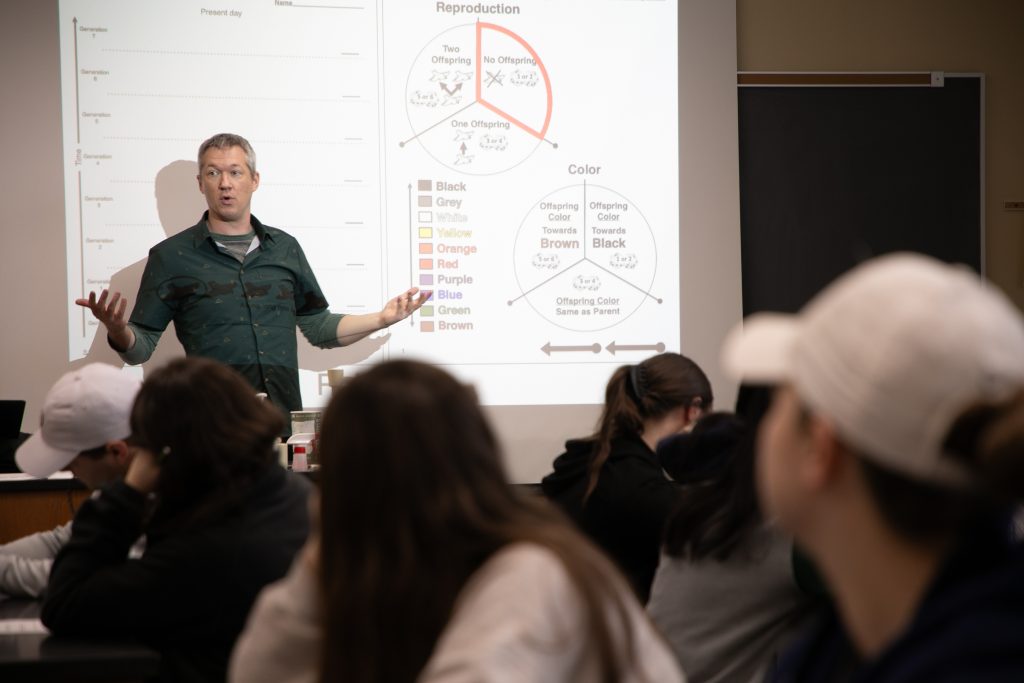Hagey awarded $1M NSF Grant
Dr. Travis Hagey, associate professor of biology at Mississippi University for Women, was named among the 2024 recipients of the U.S. National Science Foundation (NSF) CAREER Award totaling a little over $1 million for five years.

The award will allow for ample field work studying gecko toepads across the globe.
Awarded to early-career faculty at eligible universities throughout the country, the Faculty Early Career Development (CAREER) Program is a competitive grant aimed at promoting research and leadership in non-tenured faculty. Applicants must submit a proposal, which is reviewed, and approximately 500 recipients are chosen nation-wide.
This was not Hagey’s first try at the grant. He previously applied in 2021 and 2022. Finally, in 2023, his proposal was taken under review and made the shortlist for candidates. Educators are only allowed three applications as well, so this was his final chance.
He was ecstatic to learn he had made the cut.
“These grants are competitive, and so it’s validating to receive one, and reassuring that other people are excited about my research as well. The award also acts as evidence that I can conduct high level research at a school like The W,” Hagey said.
Hagey has dedicated his career to studying gecko toepads and how they work. Previously, he and a W student traveled to Mauritius for field research on the Mauritia Day Geckos.
In addition to a planned return to Mauritius for further research, the grant will be used for trips to Morocco and Tanzania, as well as a hopeful trip Papua New Guinea.
Beginning in summer 2025, Hagey will travel to Morocco, and summer 2027, he will travel to Tanzania. In 2026 and 2028, W students will accompany Hagey on the trip, to get a taste of field research. Hagey said he will most likely leave students out of the first trips to each respective location so he can learn the “lay of the land.”
“Then I can kind of see what the rules are culturally and functionally and then try to bring students. So there’s money to take W students on field work. There’s also money for a Mississippi State University wildlife master student to come along[TW1] ,” Hagey said.
Hagey is what is referred to as the Principal Investigator (PI) of the grant. This means he is the point person for spending the grant funds. In addition to The W, Mississippi State University is also included in the grant, specifically the engineering and biology departments.
“I won’t be doing all this work alone. In preparing for this project, in addition to the international scientists we’ll be working with in Morocco and Tanzania, I also reached out to engineers and biologists at Mississippi State to be involved in the project,” Hagey said.
“The grant will pay the student’s tuition, stipend, etc. This student’s project will be to develop engineering simulations, called finite element simulations, that will digitally recreate how gecko toe pads work. The simulations will use the 3D images we generate from the laser microscope, predicting how sticky a gecko should be on a given surface, which we can then also test with the force sensors we’ll have, and connect back to our measurements from Morocco and Tanzania. With these simulations, we’ll be able to predict how different kinds of gecko toe pads work, even if those types of toe pads don’t exist in real life. We’ll even be able to predict how sticky extinct species were, and also design synthetic adhesives that mimic gecko toe pads,” Hagey added.
The grant will also be utilized for purchasing new equipment for Hagey’s lab at The W, which will further improve the research he and students are able to conduct.
Among the equipment, he plans to purchase a 3D laser microscope. Traditionally, a scanning electron microscope is used for this type of research, however, it doesn’t allow for the true scale of the object being photographed.
“With this laser microscope, if we mount the specimen the right way, we’ll be able to build a kind of a three-dimensional model of the outer layer of the hairs (on the toe pads) at least. It won’t give us as high resolution as a as an SEM, but it will give us more accurate measurements,” Hagey said.
He also plans to build a testing apparatus to measure the stickiness of the toe pads, and will also work hand-in-hand with the engineering simulation being created.
Ultimately, the grant will provide opportunities to not only Hagey but students at both The W and MSU, allowing them to gain experience in their chosen field before graduation.
Community impact
The grant also allots money for community programming.
Hagey plans to use a portion of the funds to continue the summer STEM course for middle school students, held at Plymouth Bluff Environmental Center, or even start one for high school aged students in addition to the middle school program.
Money is also earmarked for the Natural History Museum in Jackson to set up an interactive gecko exhibit that will be constructed at the end of the grant period, using the findings of the research.
About NSF
The U.S. National Science Foundation is an independent federal agency that supports science and engineering in all 50 states and U.S. territories. NSF was established in 1950 by Congress to promote the progress of science; advance the national health, prosperity and welfare; and secure the national defense.